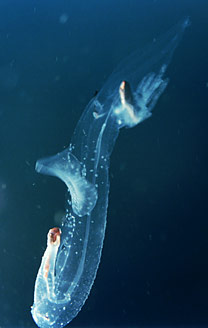![[Ocean Oasis Field Guide]](images/bnr-oo-field.gif)

![[Ocean Oasis Field Guide]](images/bnr-oo-field.gif) |  |
|
Pterotrachea coronata |
Phylum Mollusca |
DescriptionThe sea elephant is a pelagic mollusk with an elongate, cylindrical body that is divided into three regions: proboscis (hence, the name sea elephants), trunk and tail. Unlike species comprising the other two families (Atlantidae and Carinaridae), the pterotracheids lack a shell and, except in one species, tentacles immediately anterior to the eyes. The swimming fin is well-developed and in males possesses a sucker on its ventral margin. Size: To 33 cm (about 12 inches) Range and HabitatThe sea elephant is found in the Gulf of California, as well as in most tropical and subtropical oceans. Natural HistoryHeteropods are very mobile fast swimming carnivores. Because of low population densities, encounters with these animals are unlikely, but we were very lucky to be able to film one in Ocean Oasis. When Iliana Ortega, the diver in the movie, approaches what she calls "the little sea elephant," the turbulence of her swimming causes Pterotrachea to respond with rapid downward swimming, which involves the undulation of its entire body in conjunction with sculling of the swimming fin. These animals swim only when pursuing prey or avoiding capture. Because a similar rapid, downward swimming response has been reported by a number of other divers when they have encountered these animals, this behavior should be interpreted as the normal "escape response" by the animals. At other times, the animals are curled into loose balls and are motionless; neither sinking nor rising toward the surface. Interestingly, a study conducted in the early 1960's showed that neutral buoyancy P. coronata results from the partial replacement of heavy sulfate ions by light chloride ions in the body fluids. Pterotrachea are among some of the most beautiful and interesting animals of the plankton. They spend their entire lives in the water column. The evolutionary trends for the heteropods in general include morphological adaptations for life in the open ocean such as a reduction of the shell (in size and weight), or loss of the shell associated with an increase in body size, the development of a single swimming fin derived from the gastropod foot, and a tendency for the body and shell to be transparent. (Lalli and Gilmer. 1989. Pelagic snails. Stanford Press.) P. coronata is the largest, the most streamlined, and the fastest swimming species of heteropod. Its body is transparent except for the visceral nucleus and the eyes, which greatly improves the likelihood of not being seen by predators!
Larry Lovell, Collection Manager of the Benthic Invertebrate Collection at
Scripps Institution of Oceanography (SIO) identified the organism in the Ocean Oasis film.
For more information on natural history, biology and
ecology of this animal contact: Dr. Roger Seapy at California State
University, Fullerton: rseapy@fullerton.edu |

|
Text by Patricia Beller
Photograph from Ocean Oasis © 2000 CinemaCorp of the Californias
Field Guide |
Site Index |
Ocean Oasis Introduction
|
|
© 2000 San Diego Natural History Museum |